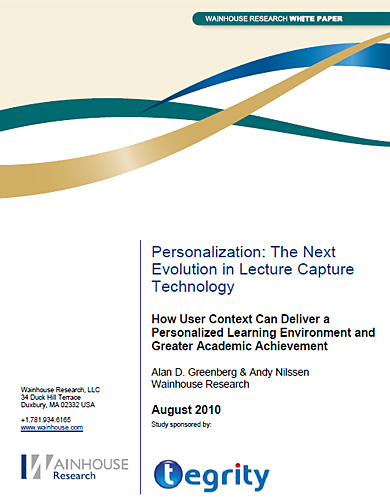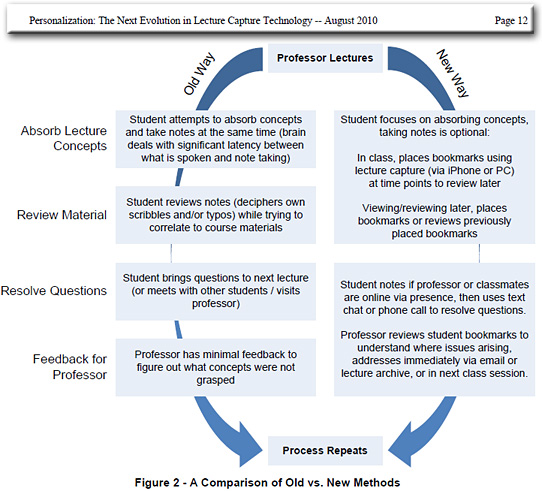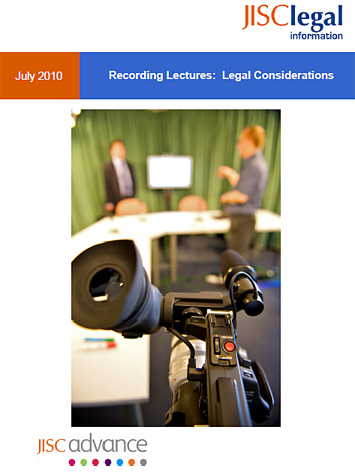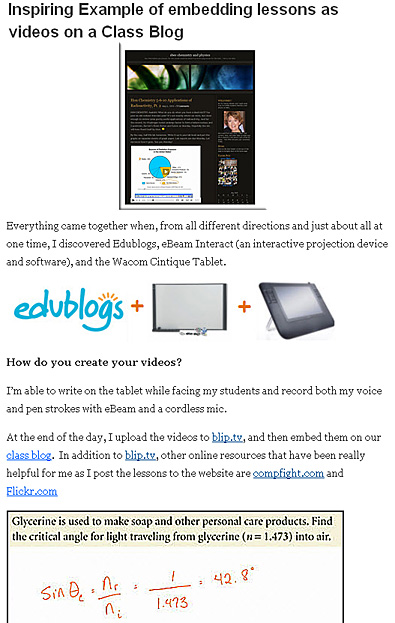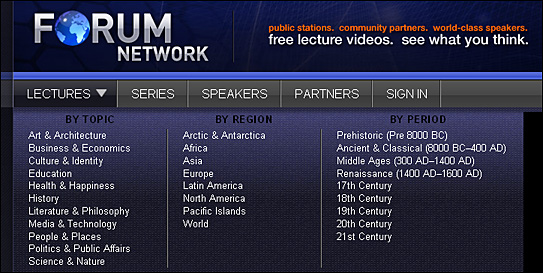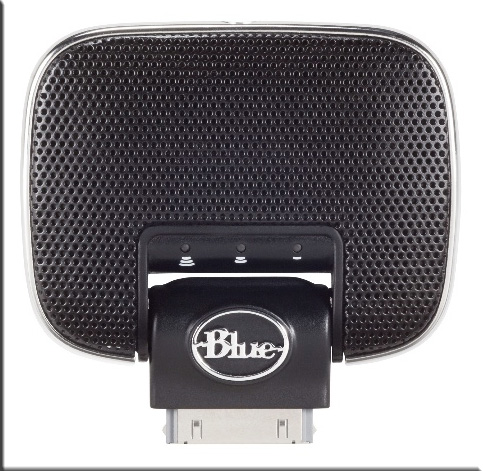Lecture Capture: A Guide for Effective Use — from Tomorrow’s Professor blog
References from that posting include:
Bongey, S. B., Cizadlo, G., & Kalnbach, L. (2006). Explorations in course-casting: Podcasts in higher education. Campus-Wide Information Systems, 23(5), 350-367.
Brittain, S., Glowacki, P., Van Ittersum, J., & Johnson, L. (2006). Podcasting lectures. Educause Quarterly, 3, 24-31.
Brotherton, J. A., & Abowd, G. D. (2004). Lessons learned from eClass: Assessing automated capture and access in the classroom. Transactions on Computer-Human Interaction 11(2), 121-155.
Coghlan, E., Futey, D., Little, J., Lomas, C., Oblinger, D., & Windham, C. (2007). ELI Discovery Tool: Guide to Podcasting. Retrieved from http://www.educause.edu/ GuideToPodcasting/12830
Copley, J. (2007). Audio and video podcasts of lectures for campus-based students: Production and evaluation of student use. Innovations in Education and Teaching International, 44(4), 387-399.
Dale, C. (2007). Strategies for using podcasting to support student learning. Journal of Hospitality, Leisure, Sport and Tourism Education, 6(1), 49-57.
Dey, E. L., Burn, H. E., & Gerdes, D. (2009). Bringing the classroom to the Web: Effects of using new technologies to capture and deliver lectures. Research in Higher Education, 50(4), 377-393.
Duke University Center for Instructional Technology. (2005). Duke University iPod First-Year Experience
Final Evaluation Report 2005. Retrieved from http://cit.duke.edu/pdf/reports/ipod_initiative_04_05.pdf
Edirisingha, P., & Salmon, G. (2007). Pedagogical models for podcasts in higher education. LRA/BDRA demonstration file, conference pre-print copy. Retrieved from http://www2.le.ac.uk/projects/impala
Evans, C. (2007). The effectiveness of m-learning in the form of podcast revision lectures in higher education. Computers & Education, 50, 491-498.
Fernandez, V., Simo, P., & Sallan, J. M. (2009). Podcasting: A new technological tool to facilitate good practice in higher education. Computers & Education, 53, 385-392.
Flanagan, B., & Calandra, B. (2005). Podcasting in the classroom. Learning & Leading with Technology, 33(3), 20-25.
Harrity, M. B., & Ricci, A. (n.d.). How course lecture capture can enhance student learning. Retrieved from http://www.wpi.edu/Academics/ATC/ Collaboratory/News/NERCOMPHandout.pdf
Kim, J. (2009). Capturing lectures: No brainer or sticky wicket? Educause Research Bulletin, 2009(24), 1-10. Retrieved from http://www.educause.edu/Resources/ CapturingLecturesNoBrainerorSt/192206
Lane, C. (2006). Podcasting at the UW: An evaluation of current use. Retrieved from http://catalyst.washington.edu/research_development/papers/2006/ podcasting_report.pdf
Lewis, J., Coursol, D., & Khan, L. (2001). College students@tech.edu: A study of comfort and the use of technology. Journal of College Student Development, 42(6), 625-631.
Lund, C. R. F. (2008). Moving lectures out of the classroom to make room for learning [PowerPoint slides]. Retrieved from http://www.ubtlc.buffalo.edu/ workshops/handout.asp?titleID=170&eventID=639
McKenzie, W. A. (2008). Where are audio recordings of lectures in the new educational technology landscape? In Hello! Where are you in the landscape of educational technology? Proceedings ascilite Melbourne 2008. Retrieved from http://www.ascilite.org.au/conferences/melbourne08/procs/mckenzie-w.pdf
Nagel, D. (2008, September). Lecture capture: No longer optional? Campus Technology. Retrieved from http://www.campustechnology.com/Articles/2008/09/
Pinder-Grover, T., Millunchick, J. M., & Bierwert, C. (2008, October). Work in progress: Using screencasts to enhance student learning in a large lecture material science and engineering course. Proceedings of the 38th IEEE/ASEE Frontiers in Education Conference. Saratoga Springs, NY. Retrieved from http://fieconference.org/fie2008/papers/1362.pdf
Pinder-Grover, T., Millunchick, J. M., Bierwert, C., & Shuller, L. (2009, June). The efficacy of screencasts on diverse students in a large lecture course. Paper presented at American Society for Engineering Education, Austin TX. Retrieved from http://soa.asee.org/paper/conference/paper-view.cfm?id=11305
Soong, A. S. K., Chan, L. K., Cheers, C., & Hu, C. (2006). Impact of video recorded lectures among students. In L. Markauskaite, P. Goodyear, & P. Reimann (Eds.), Who’s learning? Whose technology? (pp. 789-794). Sydney, Australia: Sydney University Press.
Veeramani, R., & Bradley, S. (2008). U-W Madison onlinelearning study: Insights regarding undergraduate preference for lecture capture. Retrieved from http://www.uwebi.org/news/uw-online-learning.pdf
Vogele, C., Garlick, M., & The Berkman Center Clinical Program in Cyberlaw. (2006). Podcasting Legal Guide. Retrieved from http://wiki.creativecommons.org/Podcasting_Legal_Guide
Winterbottom, S. (2007). Virtual lecturing: Delivering lectures using screencasting and podcasting technology. Planet, 18, 6-8.
Young, J. R. (2008, January 25). YouTube professors: Scholars as online video stars. Chronicle of Higher Education. Retrieved from http://chronicle.com/article/YouTube-Professors-Scholars/22847/
Zhu, E., & Kaplan, M. (2011). Technology and teaching. In M. Svinicki & W. J. McKeachie (Eds.), Teaching tips: Strategies, research and theory for college and university teachers (13th ed., pp. 235-366). Belmont, CA: Wadsworth, Cengage Learning.









